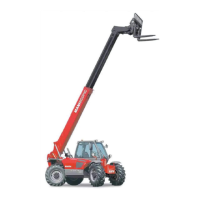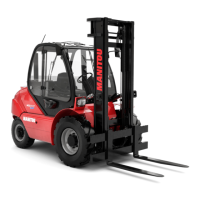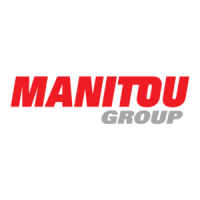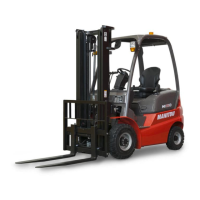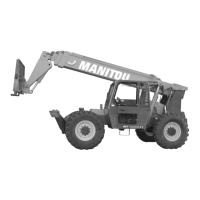ROUGH TERRAIN FORKLIFT ROUGH TERRAIN FORKLIFT TRUCK GENERAL SAFETY STANDARDS (cont.)TRUCK GENERAL SAFETY STANDARDS (cont.)
C.) OPERATING SAFETY RULES AND PRACTICES (cont.)C.) OPERATING SAFETY RULES AND PRACTICES (cont.)
46.) When attachments are used, extra care shall be taken in securing, manipulating, positioning, and trans-46.) When attachments are used, extra care shall be taken in securing, manipulating, positioning, and trans-
porting the load. porting the load. Operate rough terrain foOperate rough terrain forklift trucks equipped with attrklift trucks equipped with attachments as partachments as partially loaded trucksially loaded trucks
when not handling a load.when not handling a load.
47.) Completely engage the load with th47.) Completely engage the load with the load-engaging means. e load-engaging means. Fork length should be at least two-thirFork length should be at least two-thirds ofds of
load length. load length. Where tilt is provided, carefully tilt Where tilt is provided, carefully tilt the load backward to stabilize the load backward to stabilize the load. the load. Caution should be usedCaution should be used
in tilting backward with high or segmented loads.in tilting backward with high or segmented loads.
48.) Use extreme care when tilting load forward or backward, particularly when high tiering. 48.) Use extreme care when tilting load forward or backward, particularly when high tiering. Do not tilt forwardDo not tilt forward
with load-engaging means elevated except to pick up or deposwith load-engaging means elevated except to pick up or deposit a load over a rack or stack. it a load over a rack or stack. When stackingWhen stacking
or tiering, use only enough backward tilt to stabilize the load.or tiering, use only enough backward tilt to stabilize the load.
49.) The handling of suspended loads by means 49.) The handling of suspended loads by means of a crane arm (boom) or other of a crane arm (boom) or other device can introduce dynam-device can introduce dynam-
ic forces affecting the stability of a rouic forces affecting the stability of a rough terrain forklift truck. gh terrain forklift truck. Grades and sudden startGrades and sudden starts, stops, and turns cans, stops, and turns can
cause the load to swing and creacause the load to swing and create a hazard if not externally stte a hazard if not externally stabilized. abilized. When handling suspended loads:When handling suspended loads:
a.) do not exceed the truck manufacturer’s capacity of the rough terrain forklift truck as equippeda.) do not exceed the truck manufacturer’s capacity of the rough terrain forklift truck as equipped
for handling suspended loads.for handling suspended loads.
b.) only lift the load vertically and never drag it horizontally;b.) only lift the load vertically and never drag it horizontally;
c.) transport the load with the bottom of the load and the mast as low as possible;c.) transport the load with the bottom of the load and the mast as low as possible;
d.) with load elevated, maneuver the rough terrain forklift truck slowly and cautiously, and only tod.) with load elevated, maneuver the rough terrain forklift truck slowly and cautiously, and only to
the extent necessary to permit lowering to the transport position;the extent necessary to permit lowering to the transport position;
e.) use tag lines to restrain load swing whenever possible.e.) use tag lines to restrain load swing whenever possible.
50.) At the beginning of each shift and before operating the rough terrain forklift truck, check its condition,50.) At the beginning of each shift and before operating the rough terrain forklift truck, check its condition,
giving giving special special attention attention to:to:
a.) tires and their inflation pressurea.) tires and their inflation pressure
b.) warning devicesb.) warning devices
c.) lightsc.) lights
d.) lift and tilt systems, load-engaging means, chains, cables, and limit switchesd.) lift and tilt systems, load-engaging means, chains, cables, and limit switches
e.) brakese.) brakes
f.) steering mechanismf.) steering mechanism
g.) fuel system(s)g.) fuel system(s)
51.) If the rough terrain forklift truck is found to be in need of repair or in any way unsafe, or if it contributes to51.) If the rough terrain forklift truck is found to be in need of repair or in any way unsafe, or if it contributes to
an unsafe condition, the matter shall be reported immediately to an unsafe condition, the matter shall be reported immediately to the user’s designated authority, and the truckthe user’s designated authority, and the truck
shall not be operated until it has been restored to safe operating condition.shall not be operated until it has been restored to safe operating condition.
52.) If during operation the rough terrain forklift truck becomes unsafe in any way, the matter shall be reported52.) If during operation the rough terrain forklift truck becomes unsafe in any way, the matter shall be reported
immediately to the user’s designated authority, and the truck shall not be operated until immediately to the user’s designated authority, and the truck shall not be operated until it has been restored toit has been restored to
safe operating condition.safe operating condition.
53.) Do not make repairs or adjustments unless specifically authorized to do so.53.) Do not make repairs or adjustments unless specifically authorized to do so.
54.) When refueling, smoking in the area shall not be permitted, the engine shall be stopped, and the opera-54.) When refueling, smoking in the area shall not be permitted, the engine shall be stopped, and the opera-
tor shall not be on the rough terrain forklifttor shall not be on the rough terrain forklift
truck.truck.
55.) Spillage of oil or fuel shall be 55.) Spillage of oil or fuel shall be carefully and completely absorbed or evaporated and fuel tank cap replacedcarefully and completely absorbed or evaporated and fuel tank cap replaced
before restarting engine.before restarting engine.
56.) Do not use open flames when checking electrolyte level in storage batteries, liquid level in fuel tanks, or56.) Do not use open flames when checking electrolyte level in storage batteries, liquid level in fuel tanks, or
the condition of LPG fuel lines and connectors.the condition of LPG fuel lines and connectors.
57.) Do not lift personnel with the forklift. 57.) Do not lift personnel with the forklift. If the forklift must be used to lift people, precautions for the protec-If the forklift must be used to lift people, precautions for the protec-
tion of the personnel must be taken (see ITSDF B56.6, chapter 5.15 Elevating Personnel).tion of the personnel must be taken (see ITSDF B56.6, chapter 5.15 Elevating Personnel).
VV
